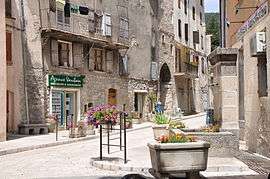Annot
| Annot | ||
|---|---|---|
|
Entrance to the old town of Annot | ||
| ||
 Annot | ||
|
Location within Provence-A.-C.d'A. region  Annot | ||
| Coordinates: 43°57′57″N 6°40′10″E / 43.9658°N 6.6694°ECoordinates: 43°57′57″N 6°40′10″E / 43.9658°N 6.6694°E | ||
| Country | France | |
| Region | Provence-Alpes-Côte d'Azur | |
| Department | Alpes-de-Haute-Provence | |
| Arrondissement | Castellane | |
| Canton | Annot | |
| Intercommunality | Terres de Lumière | |
| Government | ||
| • Mayor (2008–2020) | Jean Ballester | |
| Area1 | 29.8 km2 (11.5 sq mi) | |
| Population (2009)2 | 1,046 | |
| • Density | 35/km2 (91/sq mi) | |
| Time zone | CET (UTC+1) | |
| • Summer (DST) | CEST (UTC+2) | |
| INSEE/Postal code | 04008 / 04240 | |
| Elevation |
599–1,638 m (1,965–5,374 ft) (avg. 680 m or 2,230 ft) | |
|
1 French Land Register data, which excludes lakes, ponds, glaciers > 1 km² (0.386 sq mi or 247 acres) and river estuaries. 2 Population without double counting: residents of multiple communes (e.g., students and military personnel) only counted once. | ||
Annot is a French commune in the Alpes-de-Haute-Provence department in the Provence-Alpes-Côte d'Azur region of southeastern France.
The inhabitants of the commune are known as Annotains or Annotaines[1]
The commune has been awarded one flower by the National Council of Towns and Villages in Bloom in the Competition of cities and villages in Bloom.[2]
Geography
Annot is located some 80 km north-west of Nice, 15 km east of Saint-Andre-les-Alpes, and 13 km west of Puget-Theniers. Access to the commune is by National Road N202 from Saint-Andre-les-Alpes to Puget-Theniers which passes through the south of the commune. Access to the village is by road D908 running north off the N202 and continuing north to Le Fugeret.[3] There are two railway stations in the commune: Scaffarels station, an optional stop built on a masonry embankment; and Annot Railway Station near the village. They are both served by the line from Nice to Digne.[4]
The hamlet of Les Scaffarels is south-east of the village and there is also the hamlet of Rouaine on the N202 in the south. The commune is mountainous and heavily forested. The forests occupy 2,712 hectares of the commune.[5]
The Galange river forms most of the southern border of the commune while the Vaire flows from north to south past the village gathering many tributaries through the commune. The Beite river joins the Vaire at the village while the Canal des Gastres flows south-east near the village then curves north to join the Coulomp just north-east of the commune.
Geology
The village is located within a resurgence of sandstone amidst limestone mountains at 680 m altitude. This resurgence is up to 250m thick. The rocky ridge overlooking the village is formed of sandstone. The debris that has formed below in picturesque shapes with names such as: the Dent du Diable (Tooth of the Devil), the Chambre du Roi (King's Chamber), the défilé des Garambes (Defile of Garambes), the Chameau des lumières (Camelback of lights), and the rocks of the Cent-Marches (Hundred Steps). It has been classed as a natural site since 1920.[6] Certain houses have been built directly against a rock fallen from the crag: the rock is bigger than a house. The acidic soils on the left bank of the Vaïre allow for chestnut growing.
The centre of the town (Saint-Jean-Baptiste Church, formerly Saint-Pons) has been built on a rocky outcrop between the Vaïre and Beïte rivers.
- High points
- Pelloussis Rock (1,340 m)
- Col de L'Iscle (1,384 m)
- on the same ridge west of the village: Le Roncheret (1,617 m), Le Puel (1,532 m), La Colle Durand (1,638 m), the Rocks of Rouaine (1,438 m)
Natural and technological risks
None of the 200 communes of the department is in a no seismic risk zone. The Canton of Annot is in zone 1b (low risk) according to the deterministic classification of 1991 based on the historical seismic data[7] and in zone 4 (medium risk) according to the probabilistic classification EC8 of 2011.[7] The town of Annot is also exposed to three other natural hazards:[8]
- forest fire
- flooding (in the valley of the Vaïre)
- landslide
The commune of Annot is also exposed to a risk of technological origin: the transport of dangerous goods by road.[7] The N202 national road can be traveled by carriers of dangerous goods.[7]
The foreseeable natural risk prevention plan (PPR) of the commune was approved in 1990 for flood risk, landslide, and earthquake[7] but a new one was requested in 2003 and a DICRIM has existed since 2011.[9]
The town has had several natural disasters from flooding and mudslides in 1994[8] and an earthquake powerfully felt in the town on 17 February 1947 whose epicentre was located in the Piedmont.[10]
Neighbouring communes and villages
 |
Le Fugeret | Braux |  | |
| Saint-Andre-les-Alpes | |
Entrevaux | ||
| ||||
| | ||||
| Vergons | Ubraye | Val-de-Chalvagne |
Toponymy
The locality appears for the first time in charters of 1042 as Anoth when its Lord, Ermerincus of Anoth, gave it to the Abbey of Saint Victor, Marseille. The name perhaps comes from the Gallic ana plus the Latin suffix ottum designating a small marsh.[11][12] Charles Rostaing thought that the name Ana designated it as an older town which preceded the upper town called Sigumanna.[13] According to Daniel Thiery, the name Sigumanna, cited in the same document as Annot, means the territory rather than a place or a specific village and this name of the territory is probably derived from the name of pre-Roman people who occupied the valley.[14]
The commune name is Anòt in Provençal.
The name of the hamlet of Rouaine comes from the Roman name *Rugius with the suffix -ane indicating the domain of Rugius.[15]
History
Antiquity
The name of the people settled in the valley on the arrival of the Romans is not certain, but it may be the Nemeturii. An oppidum was located at a place called Vers-la-Ville.[16]
Middle Ages

The original village was probably in the middle of "Grès d'Annot" (Annot sandstone). The houses were mostly wooden (locations for beams are visible in the rocks that the houses backed on to) and more than one floor. The path called "Vers-la-Ville" leading to a chapel is certainly a testimony to its past existence. On this path there is a large sandstone rock ("the rock of 100 steps") on which a staircase is carved. Around the rock's summit there are holes dug to accommodate wooden beams.
Subsequently the village was built between the Vaïre and Beite rivers and was fortified around the church of Saint-Pons in 1042.[17] The Lord was the Abbey of Saint Victor, Marseille, who received very many gifts.[14] The Abbey shared some rights with the Order of the Temple.[18][19] After the dissolution of the Order of the Temple, its property at Fugeret and Annot passed to the Abbey Saint-Pons of Nice.[14]
The lordship then passed to the counts of Provence.[18] The death of Queen Joanna I created a succession crisis for the head of the County of Provence. The towns of the Union of Aix (1382-1387) supported Charles de Duras against Louis I of Anjou. The Annot community supported Duras until 1386 then switched sides to join the Angevins through patient negotiations by Marie de Blois, widow of Louis I and regent for their son Louis II. The surrender of Aix could also have played a role in the turnaround of the community.[20]
A Fair was established in 1388 by Marie de Blois which was maintained until the end of the Ancien Régime.[17][21][22] She also authorised a weekly market.[23] Finally in the 15th and 16th centuries it was the Saint-Pons family who were the Lords.[18]
Modern Times
During the Wars of religion the city was attacked by the Protestants in 1574[24] commanded by the Baron of l'Isle.[25] Annot was spared the plague epidemics of 1626 and 1670 which nevertheless affected Castellane and Entrevaux.[26]
In May 1672 the entire population of the village, led by the notaries and the apothecary, repulsed the new vicar who had been imposed by the diocese and not from the country.[27]
At the end of the 17th century the village was gradually emerging from isolation: the Bishop of Entrevaux, Ithier, established a fortnightly postal service between Entrevaux and Aix by mules, which also served Annot and Guillaumes.[28][29] The culture of Roman law, which requires frequent use of a notary, was very much alive: thus four notaries were established in Annot in 1680.[28] In the 18th century a viguerie was installed at Annot which also served the communities of Braux, La Colle, Fugeret, Méailles, Argenton, Peyresc, and Saint-Benoît.[23]
In June 1704, as part of the War of the Spanish Succession, a communal militia was raised at Ubraye and Annot. They were repulsed by the Savoyards in the Valley of Marguery, and many residents of both communities were taken prisoner. The ransom for those from Annot amounted to 1,200 livres.[30]
The French Revolution
The community was fully part of the movement of the French Revolution. After sending their complaints in 1789, they planted a tree of liberty in the Place Revelly.[31] The patriotic society of the commune was created during the summer of 1792:[32] it was called the Club of Friends of the Revolution.[31]
19th and 20th centuries
In the 19th century the commune was experiencing some industrial development through the spinning and weaving of wool on the model of the Honnorat factory in Saint-André-de-Méouilles.[33] The Moulard factory opened in the early 1830s and the Roux factory in 1836 (but it disappeared before 1843[34]). In 1856 two factories employed 40 workers.[35]
The railway arrived at Annot in 1908 with the opening of the penultimate section of the line from Nice to Digne.[36] The Colle tunnel was completed in 1903 and the entire line between Nice and Digne was opened from 5 to 7 August 1911 in the presence of Victor Augagneur, Minister of Public Works.[37]
During the First World War soldiers were assigned to Annot to defend the railway lines for Railways of Provence.
The doctor from Annot belonged to the Milice. His father was shot on 6 August 1944 by the Francs-Tireurs et Partisans from the 11th company.[38]
Until the middle of the 20th century there was a vineyard in Annot whose production was consumed locally and was exported. There remains nothing now.[39]
21st century
On 9 February 2014, a rock tumbled down a mountainside and derailed a train on the Chemins de Fer de Provence near Annot, killing two passengers.
Heraldry
The town of Annot used at least two different shields, both making reference to chestnuts. The current arms of Annot are the second described below without picture.
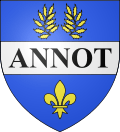 |
These arms. are not dated. It is possible that they are the oldest in the community.
Blazon: |
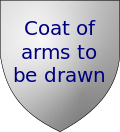 |
These arms existed in 1648[41]
Blazon: |
Administration
List of Successive Mayors[43]
| From | To | Name | Party | Position |
|---|---|---|---|---|
| 1977 | Fernand Faissole | |||
| 1977 | 2001 | Yves Bono | ||
| 2001 | 2020 | Jean Ballester | SE |
(Not all data is known)
Inter-communality
Annot is part of:
- Since 2004: the Community of communes Terres de Lumière (of which it is the seat)
Education
The commune has a computerized library (catalogue online).
The town has two educational institutions:
Demography
Prior to 1793 the commune had 69 fires in 1471 and 1,023 inhabitants in 1765[18]
In 2009 the commune had 1,046 inhabitants. The evolution of the number of inhabitants is known from the population censuses conducted in the commune since 1793. From the 21st century, a census of communes with fewer than 10,000 inhabitants is held every five years, unlike larger towns that have a sample survey every year.[Note 1]
| 1793 | 1800 | 1806 | 1821 | 1831 | 1836 | 1841 | 1846 | 1851 |
|---|---|---|---|---|---|---|---|---|
| 1,190 | 1,072 | 1,068 | 1,160 | 1,292 | 1,197 | 1,178 | 1,149 | 1,144 |
| 1856 | 1861 | 1866 | 1872 | 1876 | 1881 | 1886 | 1891 | 1896 |
|---|---|---|---|---|---|---|---|---|
| 1,161 | 1,162 | 1,137 | 1,140 | 989 | 1,036 | 1,069 | 1,046 | 1,015 |
| 1901 | 1906 | 1911 | 1921 | 1926 | 1931 | 1936 | 1946 | 1954 |
|---|---|---|---|---|---|---|---|---|
| 1,096 | 1,473 | 1,109 | 825 | 978 | 992 | 1,018 | 1,018 | 920 |
| 1962 | 1968 | 1975 | 1982 | 1990 | 1999 | 2006 | 2009 | - |
|---|---|---|---|---|---|---|---|---|
| 920 | 846 | 859 | 1,035 | 1,053 | 988 | - | 1,046 | - |
Sources : Ldh/EHESS/Cassini until 1962, INSEE database from 1968 (population without double counting and municipal population from 2006)
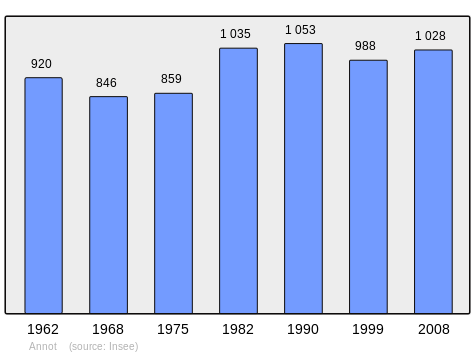
Economy
Overview
In 2009 the working population stood at 460 people, including 38 unemployed[46] (70 in late 2011[46]). The workers are mostly employed (81%)[46] and work mainly in the commune (74%).[46] Most of the workers are employed in industry and construction (55% in 2010).[46] Agriculture does not provide any employment. Services and administration, with 140 jobs, takes up the remaining 45% of the working population.[46]
On 1 January 2011 establishments active in the town were mainly shops and services (80 out of 132 establishments) followed by firms in the secondary sector (22 of 132), the government, health, the social sector, and education (24 establishments).[46]
Agriculture
At the end of 2010 the primary sector (agriculture, forestry, fisheries) had 6 different establishments.[46] A cheese bears the appellation Fromage d'Annot or Tomme d'Annot.
Industry
At the end of 2010 the secondary sector (industry and construction) had 22 establishments and employed 173 employees.[46]
The main employer in the town is the Faissole[47] biscuit factory which has produced biscuits and toasted buns since the 1960s[47] and employs 118 employees with an annual turnover of €11 million.[48] The agri-food sector also has the Rigault and Co. factory for cured meats with 18 employees.[49]
A small central hydroelectric plant is installed on the Vaïre near Scaffarels. The water chute is 46 m high and drives a turbine of 820 kW. Production is currently halted from July to October. The plant is equipped with a fish slide.[50]
Service activities
At the end of 2010 the tertiary sector (trades and services) had 80 establishments with 57 employees plus another 24 administrative establishments employing 83 people.[46]
According to Departmental Observatory of Tourism, the tourist function is important for the town, with between 1 and 5 tourists welcomed per year per inhabitant.[51] Most of the accommodation capacity is non-market.[52] Several tourist accommodation structures exist in the commune:
- several hotels[53] (1 classified 1-star[54] and 2 classified 2-star[55]).[56] These three hotels have a total capacity of 32 rooms;[46][56]
- a 2-star camping site[57] with 66 places;[46][56] *several furnished units;[58]
- collective accommodation is provided by a vacation village managed by the commune[59][60] and a cottage (The Roncharels).[61]
Overall, second homes add a significant extra accommodation capacity in the commune[62] with 275 homes (one third of the houses in the town).[46]
In summer, the passage of the steam train on the line from Nice to Digne between Puget-Théniers and Annot adds significant tourist activity to the commune.[63] In 2006-2007 this increased the patronage on the line by 50 to 60%.[64]
An Equestrian Centre is located in the commune.[65]
Tourism
Annot is well regarded for bouldering and is particularly popular among climbers, as the second biggest developed area of that kind in France.[66]
Culture and heritage
Civil heritage
- The Pont de la Donne (Bridge over the Donne) (1709).
 is registered as an historical monument.[67] It is partly in the commune of Saint-Benoît.
is registered as an historical monument.[67] It is partly in the commune of Saint-Benoît. - The Old town and medieval alleys. A lintel bears the date of 1377 which is apocryphal according to Raymond Collier[68] as it is contrary to other lintels dated 1455 and 1533[69]
- The Bridge over the Beite and its surroundings
- The Arcade Houses in the arcade on the Rue Notre Dame
- A Fortified Gate in the old town;
- The Place of plane trees along the Vaïre
- A Coaching Inn in Rouaine which is still used as a hotel-restaurant.[70]
- A Fountain with the inscription RF 1894
- The Hôtel-Dieu from the 17th century
- The Town hall from the 17th century
- Views of Annot town.
-

Jeu Provençal on the Place of Plane Trees in 1909.
-

The Fortified Gate.
-

Houses in the arcades.
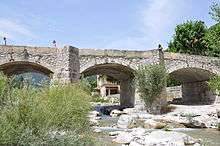
- The Bridge over the Vaïre is 34 metres long[71][72] and 3.5 metres wide. It succeeded another bridge built in 1676. The community of Annot first built it with stone piers[71] by the master masons François Richard, Louis Borrely, and Louis Fabre.[72] These piers are protected by strong front and rear Starlings with handrails provided on top of the starlings. On these piles a wooden deck was built[71] which allowed rapid commissioning in 1682.[72] The wooden deck was replaced by a stone deck at the beginning of the 18th century. It was the object of repair works in 1777. In 1932 the square in the village was enlarged and the two main arches were sealed.
Religious heritage
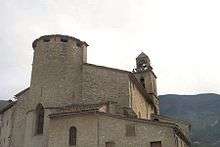
The commune has several religious buildings and structures that are registered as historical monuments:
- The Parish Church of Saint John the Baptist (12th century)
 [73] (formerly Saint-Pons[74][75]) is in the old town.[76] Initially a simple priory, it took on the function of a parish church at the time of the constitution of castrum in the late 12th century.[14] It was built with a semi-circular apse,[76] a semi-circular vault which is the only part of the church which is entirely Romanesque.[74] It is extended by a hemispherical tower. An aisle was added or rebuilt in the 15th or 16th centuries in the Gothic style.[77] The nave was rebuilt in the 17th century.[78] The church has a very large number of items which have been registered as historical objects. For a complete list including links to descriptions (in French) click here. Items not on the list are:
[73] (formerly Saint-Pons[74][75]) is in the old town.[76] Initially a simple priory, it took on the function of a parish church at the time of the constitution of castrum in the late 12th century.[14] It was built with a semi-circular apse,[76] a semi-circular vault which is the only part of the church which is entirely Romanesque.[74] It is extended by a hemispherical tower. An aisle was added or rebuilt in the 15th or 16th centuries in the Gothic style.[77] The nave was rebuilt in the 17th century.[78] The church has a very large number of items which have been registered as historical objects. For a complete list including links to descriptions (in French) click here. Items not on the list are:
- A Monstrance (19th century)
 [79]
[79] - A Chalice (19th century)
 [80]
[80] - A Ciborium (19th century)
 [81]
[81] - A Statue: Saint Antoine (18th century)
 [82]
[82] - A Bust-Reliquary: Saint Peter (18th century)
 [83]
[83] - A Framed Painting: Baptism of Christ (18th century)
 [84]
[84] - A Statue: Saint Joseph (1863)
 [85]
[85] - A Statue: Saint John the Baptist (1862)
 [86]
[86] - A Statue: Saint Fortunat (1861)
 [87]
[87] - A Celebrant Chair (19th century)
 [88]
[88]
- A Monstrance (19th century)
- A Covered Wayside Cross (10th century)
 [89] or oratory near Route nationale N202.
[89] or oratory near Route nationale N202. - The Chapel of Notre-Dame-de-Vers-la-Ville (12th century)
 [90][91] was built on a small platform in front of a sandstone pile of rocks.[74] Probably installed in the centre of a Carolingian field, it served as a parish church until the end of the 12th century.[14] It contains many items that are registered as historical objects:
[90][91] was built on a small platform in front of a sandstone pile of rocks.[74] Probably installed in the centre of a Carolingian field, it served as a parish church until the end of the 12th century.[14] It contains many items that are registered as historical objects:
- 2 Statuettes: Cherubs holding candles (18th century)
 [92]
[92] - A Monstrance (19th century)
 [93]
[93] - A Painting: Portrait of Christ (19th century)
 [94]
[94] - A Retable and Painting: Virgin and child (18th century)
 [95]
[95] - A Painting: Virgin of Suffering (18th century)
 [96][97]
[96][97] - A Painting: Ecce homo (18th century)
 [98][99]
[98][99] - A Painting: Ecce homo (2) (19th century)
 [100]
[100] - A Statue: Virgin and child (18th century)
 [101]
[101] - A Painting: Ex-voto (18th century)
 [102][103]
[102][103] - All furniture in the Church (19th-20th century)
 [104]
[104] - A Painting Ex-voto: Virgin and child (18th century)
 [105]
[105] - A Painting: Christ between two thieves (1859)
 [106]
[106] - 2 Statuettes: Angels with torches (18th century)
 [107]
[107] - A Statue-Reliquary: Virgin and child (18th century)
 [108]
[108] - A Walnut Frame (17th century)
 [109]
[109] - A Painting: Annunciation (1656)
 [110]
[110]
- 2 Statuettes: Cherubs holding candles (18th century)
- The Parish Church of Saint Peter (17th century)
 [111] The Church has a very large number of items that are registered as historical objects. For a complete list with links to descriptions (in French) click here.
[111] The Church has a very large number of items that are registered as historical objects. For a complete list with links to descriptions (in French) click here.
- The Chapel of Notre-Dame-de-Vérimande (17th century)
 [112] The Chapel existed before the 13th century. It was then probably rebuilt in the second half of the 17th century and restored significantly in the mid-18th century then again at the end of the 19th century. It has a canopy, and Lunettes over the Bays.[113] The Chapel contains many items that are registered as historical objects:
[112] The Chapel existed before the 13th century. It was then probably rebuilt in the second half of the 17th century and restored significantly in the mid-18th century then again at the end of the 19th century. It has a canopy, and Lunettes over the Bays.[113] The Chapel contains many items that are registered as historical objects:
- A Statue: Saint Mary-Magdalene (18th century)
 [114][115]
[114][115] - A Statue: Saint Anne (18th century)
 [116][117]
[116][117] - A Bust-Reliquary: Saint Fortunat (18th century)
 [118][119]
[118][119] - A Painting: Saints Martin and Pons with the Virgin (17th century)
 [120][121]
[120][121] - A Painting: Saints Prosper, Fortunat, Innocent, and Sécure (1677)
 [122][123]
[122][123] - A Bronze Bell (1652)
 [124]
[124] - The Furniture in the Chapel (20th century)
 [125]
[125]
- A Statue: Saint Mary-Magdalene (18th century)
- The Chapel of White Penitents contains several items that are registered as historical objects:
- A Painting: Placing in the Tomb (17th century)
 [126]
[126] - A Painting: Saint Famille (17th century)
 [127]
[127] - A Bust-Reliquary: Saint Clair (18th century)
 [128]
[128] - A Bust-Reliquary: Saint Blaise (18th century)
 [129]
[129] - A Painting: Virgin and child (18th century)
 [130]
[130] - A Retable and Painting: Descent from the Cross with the white penitents and Louis XIII (1641)
 [131]
[131] - A Statue: Virgin and child (18th century)
 [132]
[132] - A Statue: Virgin and child (18th century)
 [133]
[133]
- A Painting: Placing in the Tomb (17th century)
- The Church of Saint-Pierre-aux-Liens (17th century) at Rouaine was the parish church there.[14]
- The Chapel of Sainte-Anne at Rouaine.[14]
Environmental heritage
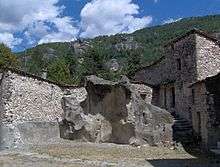
- The Grès d'Annot (Annot Sandstone), a chaos of sandstone blocks nationally known by climbers who practice climbing. They are a listed site in the Regional Directorate of the Environment and protected since 1946. They cover an area of 137 hectares in total.[6]
- The Gorge of the Galange is crossed by Route nationale N202 on the vertiginous bridge of Saint-Joseph (753 m high)
- The Defile of Garambes
Military heritage
The Medieval Ramparts are still partly visible, doors have been conserved and provide access to the old village. Tall houses surrounding the town formed the outer wall and marked the outline of the medieval city. At Vérimande there is Templar Chapel and a house said to be from the Templars: a large structure with a tower Dovecote.
Notable people linked to the commune
- Jacques Verdollin (born 29 November 1738 in Annot and died on 16 April 1793 in Paris), deputy in the States General of 1789 and the National Convention in September 1792.
- Paul Rabiers du Villars (born 2 June 1837 in Annot and died 11 May 1898 at Castellane) was elected in 1877, he saw his election invalidated.
Bibliography
- Raymond Collier, Upper-Provence Monumental and Artistic, Digne, Imprimerie Louis Jean, 1986, 559 p. (French)
- Under the direction of Édouard Baratier, Georges Duby, and Ernest Hildesheimer, Historical Atlas of Provence, Comtat Venaissin, Principality of Orange, County of Nice, Principality of Monaco, Librairie Armand Colin, Paris, 1969 (French)
- Jean-Louis Damon, Au pied du Baou Sublime. Nouvelles historiques et récits du pays d'Annot, Serre éditeur (collection les régionales), Nice, 1990 ISBN 978-2-86410-149-9 ; p. 180 (French)
See also
Notes
- ↑ At the beginning of the 21st century, the methods of identification have been modified by Law No. 2002-276 of 27 February 2002, the so-called "law of local democracy" and in particular Title V "census operations" allows, after a transitional period running from 2004 to 2008, the annual publication of the legal population of the different French administrative districts. For communes with a population greater than 10,000 inhabitants, a sample survey is conducted annually, the entire territory of these communes is taken into account at the end of the period of five years. The first "legal population" after 1999 under this new law came into force on 1 January 2009 and was based on the census of 2006.
References
- ↑ Inhabitants of Alpes-de-Haute-Provence (French)
- ↑ Annot in the Competition for Towns and Villages in Bloom Archived December 10, 2014, at the Wayback Machine. (French)
- ↑ Google Maps
- ↑ Chemins de fer de Provence, Timetables Nice-Annot-Digne-les-Bains, consulted on 22 June 2012 (French)
- ↑ Roger Brunet, Le Trésor des régions, consulted on 8 June 2013 (French)
- 1 2 Regional Directorate of the Environment, The Rocks and groups of rocks, Departmental Inventory of classified sites, DIREN, published in October 2003, consulted on 4 August 2012 (French)
- 1 2 3 4 5 Préfecture of Alpes-de-Haute-Provence, Departmental Plans for prevention of Natural risks in Alpes-de-Haute-Provence, (French)
- 1 2 Ministry of Ecology, sustainable development, transport, and lodgings, Communal Notice on the Gaspar database, placed online 27 May 2011, consulted on 25 June 2012 (French)
- ↑ DICRIM for Annot Archived January 15, 2014, at the Wayback Machine., Dicrim database, consulted on 25 June 2011 (French)
- ↑ BRGM, Epicentres of earthquake distances (more than 40 km) felt in Annot Archived January 13, 2014, at the Wayback Machine., Sisfrance, consulted on 25 June 2012
- ↑ Ernest Nègre, General Toponymy of France: Etymology of 35,000 place names, vol. 1: Pre-celtic, Celtic, and Roman Forms, Genève, Librairie Droz, coll. Publications romanes et françaises (no 193), 1990, 1869 pages (ISBN 978-2-600-02884-4). Notice 2024, p 104 (French)
- ↑ Bénédicte Fénié, Jean-Jacques Fénié, Provençale Toponymy, Éditions Sud-Ouest, 2002 (reprint), ISBN 978-2-87901-442-5, p. 41 (French)
- ↑ Charles Rostaing, Essay on the toponymy of Provence (from its origins to the barbarian invasions), Laffite Reprints, Marseille, 1973 (1st edition 1950), p 321 (French)
- 1 2 3 4 5 6 7 Daniel Thiery, Annot, On the origins of churches and rural chapels in Alpes-de-Haute-Provence, published on 12 December 2010, online on 15 December 2010, consulted on 25 June 2012 (French)
- ↑ Bénédicte Fénié, Jean-Jacques Fénié, Provençal Toponymy, Éditions Sud-Ouest, 2002 (reprint), ISBN 978-2-87901-442-5, p. 51
- ↑ Raymond Boyer and Guy Barruol, Map 12 "Peoples and habitats of the pre-Roman era", in Baratier, Duby & Hildesheimer, Historical Atlas of Provence, and commentary (French)
- 1 2 Michel de La Torre, Alpes-de-Haute-Provence: The complete guide to 200 communes, Paris, Deslogis-Lacoste, coll. "Towns and villages of France", 1989, Relié, 72 p. (non-paginated) (ISBN 2-7399-5004-7) (French)
- 1 2 3 4 Under the direction of Édouard Baratier, Georges Duby, and Ernest Hildesheimer, Historical Atlas of Provence, Comtat Venaissin, Principality of Orange, County of Nice, Principality of Monaco, Librairie Armand Colin, Paris, 1969, p. 160 (French)
- ↑ Joseph-Antoine Durbec (pref. Jacques Juillet), Templars and Hospitaliers in Provence and in Alpes-Maritimes, Grenoble, Le Mercure Dauphinois, 2001 (ISBN 2-913826-13-X), p. 28 (French)
- ↑ Geneviève Xhayet, Supporters and adversaries of Louis of Anjou during the war of the Union of Aix, Provence historique, Fédération historique de Provence, volume 40, No. 162, "Author of the War of the Union of Aix", 1990, maps p. 417-418 and p. 419. (French)
- ↑ Louis Stouff, "Map 86: Port, roads and fairs from the 13th to the 15th centuries", in Historical Atlas of Provence, Comtat Venaissin, Principality of Orange, County of Nice, Principality of Monaco, Librairie Armand Colin, Paris, 1969 (French)
- ↑ Baratier and Hilsdesheimer, "Map 122: The Fairs (1713-1789)", in Baratier, Duby & Hildesheimer, opcit (French)
- 1 2 Alfred Verdollin, Annot: around an old village and its mountains, Nice : Imprimerie Ciais, 1970. Collection Incidences et méditations, p. 34 (French)
- ↑ Jacques Cru, History of the Gorges of Verdon until the Révolution, co-edited Édisud and Parc naturel régional du Verdon, 2001, ISBN 2-7449-0139-3, p 200 (French)
- ↑ Verdollin, opcit, p. 42 (French)
- ↑ Verdollin, opcit, p. 49 (French)
- ↑ Jean Nicolas, The French rebellion: popular movements and social conscience, 1661-1789, Paris: Gallimard, 2008. Folio Collection, ISBN 978-2-07-035971-4, p. 742 (French)
- 1 2 Verdollin, opcit, p. 54 (French)
- ↑ Émile Lauga, The Post in Basses-Alpes, or the history of mail from Antiquité to the beginning of the 20th century, Digne-les-Bains, Éditions de Haute-Provence, 1994, ISBN 2-909800-64-4, p. 58 (French)
- ↑ Verdollin, opcit, p. 50 (French)
- 1 2 Verdollin, opcit, p. 66 (French)
- ↑ Patrice Alphand, "The Popular Societies", The Revolution in Basses-Alpes, Annals of Haute-Provence, Bulletin from the Scientific and Literary society of Alpes-de-Haute-Provence, no 307, 1st Trimester 1989, 108th year, p 296-297 (French)
- ↑ Mireille Mistral, The Drapery industry in the Valley of Verdon, Doctoral thesis of the State in Economic Science, Academy of Aix-en-Provence, Nice, 1951, 231 p., p 119 (French)
- ↑ Mireille Mistral, opcit, p
- ↑ Mireille Mistral, opcit, p 139 (French)
- ↑ Mathieu Golinelli, The Secondary Railways of France, 06: Department of Alpes-Maritime and Monaco Archived January 27, 2014, at the Wayback Machine., Federation of friends of secondary railways, 1997-2008, consulted on 23 June 2012 (French)
- ↑ Préfecture of Alpes-de-Haute-Provence, [Bad link: Two centuries of préfectoral activities], Préfecture of Alpes de Haute-Provence, consulted on 22 June 2012 (French)
- ↑ Raymond Moulin, "6 June 1944: the ambush of col de Toutes Aures at Vergons", Basses-Alpes 39-45 No. 4, May 2005, p. 3 (French)
- ↑ André de Réparaz, Lost land, Unchanging land, Conquered land: Vines and Olives in Haute-Provence 19th-21st centuries", Méditerranée, 109 pages, 2007, p. 56 and 59 (French) (English)
- ↑ Louis de Bresc, Arms of the communes of Provence, 1866, Reprint: Marcel Petit CPM - Raphèle-lès-Arles 1994 (French)
- ↑ JL Damon, The Valleys of the Vaïre and Coulomp: Stories and history of Annot country. Arts and popular traditions, Legends and memories of origins until the 1914-1918 war, Annot, 1988, ISBN 2-9502821-0-5, plate 1 (French)
- ↑ Achard, Historical description of towns and villages of Provence, 1787 (French)
- ↑ List of Mayors of France
- ↑ Inspection académique des Alpes-de-Haute-Provence, List of schools in the Digne district, published on 6 April 2010, consulted on 31 October 2010 (French)
- ↑ Academic Inspectorate of Alpes-de-Haute-Provence, List of public colleges, published on 6 April 2010, consulted on 31 October 2010 (French)
- 1 2 3 4 5 6 7 8 9 10 11 12 13 INSEE, Local Commune Dossier: Annot (04008), (French)
- 1 2 Faissole Official website (French)
- ↑ Chamber of Commerce and Industry of Alpes de Haute Provence, Biscottes Faissole, consulted on 19 July 2012 (French)
- ↑ Chamber of Commerce and Industry of Alpes-de-Haute-Provence, Rigault et Cie, consulted on 20 September 2012 (French)
- ↑ Mathieu Ruillet and Éric Ruchet, Study on the regional potential for development of small-scale hydro-electricity, Renewable Energy Group, environment and solidarity (GERES), 5 December 2005, p. 46 and 60 (French)
- ↑ Departmental Observatory of Tourism, Atlas of Tourist Accommodation, December 2008, p. 6 (French)
- ↑ Atlas of Tourist Accommodation, opcit, p. 7 (French)
- ↑ Atlas of Tourist Accommodation, opcit, p. 11 (French)
- ↑ Atlas of Tourist Accommodation, opcit, p. 13 (French)
- ↑ Atlas of Tourist Accommodation, opcit, p. 16 (French)
- 1 2 3 Tourist Accommodation of communes, 2008, 2009 and 2012, Insee, 2012 (Page of 20.8 Mb) (French)
- ↑ Atlas of Tourist Accommodation, opcit, p. 21 and 25 (French)
- ↑ Atlas of Tourist Accommodation, opcit, p. 32 and 36 (French)
- ↑ "Village Holidays Le Pré Martin... the name changes, the structure remains!", À l’ombre du Baou, May 2009, No. 23, p. 7 (French)
- ↑ Atlas of Tourist Accommodation, opcit, p. 30 (French)
- ↑ "29 March 2010", À l’ombre du Baou, May 2010, No. 26, p. 9 (French)
- ↑ Atlas of Tourist Accommodation, opcit, p. 44 (French)
- ↑ Bernard Viglino, "Return of steam trains to Annot Station", À l’ombre du Baou, January 2010, No. 25, p. 5 (French)
- ↑ "Assessment of the Tourist season 2007", À l’ombre du Baou, October 2007, No. 19, p. 9 (French)
- ↑ Le centre équestre d’Annot Archived October 29, 2012, at the Wayback Machine. (French)
- ↑ YDE. "Bouldering in Annot, France". www.rockclimber.de. Retrieved 2016-09-22.
- ↑ Ministry of Culture, Mérimée IA04001114 Pont de la Donne (French)
- ↑ Raymond Collier, Upper Provence Monumental and Artistic, Digne, Imprimerie Louis Jean, 1986, 559 p., p 355 (French)
- ↑ Raymond Collier, op. cit., p 357 and 366 (French)
- ↑ Raymond Collier, opcit, p 425 (French)
- 1 2 3 Notice that it was consecrated by Guy Barruol in Guy Barruol, Philippe Autran, and Jacqueline Ursch, On one side or the other: the bridges of Haute-Provence from Antiquity to today, Les Alpes de Lumière no 153, Forcalquier 2006, p 56-57. (French)
- 1 2 3 Serge Montens, The most beautiful bridges in France, Paris, Bonneton, 2001, ISBN 2-86253-275-4, p. 41 (French)
- ↑ Ministry of Culture, Mérimée IA04001392 Church of Saint John the Baptist (French)
- 1 2 3 Raymond Collier, opcit, p 116 (French)
- ↑ French Ministry of Culture Notice IA04001392 Parish Church of Saint-Jean Baptiste, consulted on 16 September 2010 (French)
- 1 2 Raymond Collier, opcit, p 76
- ↑ Raymond Collier, opcit, p 169
- ↑ Raymond Collier, opcit, p 215
- ↑ Ministry of Culture, Palissy PM04001588 Monstrance (French)
- ↑ Ministry of Culture, Palissy PM04001587 Chalice (French)
- ↑ Ministry of Culture, Palissy PM04001586 Ciborium (French)
- ↑ Ministry of Culture, Palissy PM04001585 Statue: Saint Antoine (French)
- ↑ Ministry of Culture, Palissy PM04001584 Bust-Reliquary: Saint Peter (French)
- ↑ Ministry of Culture, Palissy PM04001583 Framed Painting: Baptism of Christ (French)
- ↑ Ministry of Culture, Palissy PM04001582 Statue: Saint Joseph (French)
- ↑ Ministry of Culture, Palissy PM04001581 Statue: Saint John the Baptist (French)
- ↑ Ministry of Culture, Palissy PM04001580 Statue: Saint Fortunat (French)
- ↑ Ministry of Culture, Palissy PM04001579 Celebrant's Chair (French)
- ↑ Ministry of Culture, Mérimée PA00080351 Covered Wayside Cross (French)

- ↑ Ministry of Culture, Mérimée PA00080350 Chapel of Notre-Dame-de-Vers-la-Ville (French)

- ↑ Ministry of Culture, Mérimée IA04001385 Chapel of Notre-Dame-de-Vers-la-Ville (French)
- ↑ Ministry of Culture, Palissy PM04001595 Cherubs holding candles (French)
- ↑ Ministry of Culture, Palissy PM04001598 Monstrance (French)
- ↑ Ministry of Culture, Palissy PM04001597 Painting: Portrait of Christ (French)
- ↑ Ministry of Culture, Palissy PM04001596 Retable and Painting: Virgin and child (French)
- ↑ Ministry of Culture, Palissy PM04001594 Painting: Virgin of Suffering (French)
- ↑ Ministry of Culture, Palissy IM04002081 Painting: Virgin of Suffering (French)
- ↑ Ministry of Culture, Palissy PM04001593 Painting: Ecce homo (French)
- ↑ Ministry of Culture, Palissy IM04002082 Painting: Ecce homo (1) (French)
- ↑ Ministry of Culture, Palissy IM04002083 Painting: Ecce homo (2) (French)
- ↑ Ministry of Culture, Palissy PM04001592 Statue: Virgin and child (French)
- ↑ Ministry of Culture, Palissy PM04000015 Painting: Ex-voto (French)
- ↑ Ministry of Culture, Palissy IM04002080 Painting: Ex-voto (French)
- ↑ Ministry of Culture, Palissy IM04002084 Furniture in the Church (French)
- ↑ Ministry of Culture, Palissy IM04002079 Painting Ex-voto: Virgin and child (French)
- ↑ Ministry of Culture, Palissy IM04002078 Painting: Christ between two thieves (French)
- ↑ Ministry of Culture, Palissy IM04002077 2 Statuettes: Angels with torches (French)
- ↑ Ministry of Culture, Palissy IM04002076 Statue-Reliquary: Virgin and child (French)
- ↑ Ministry of Culture, Palissy IM04002075 Walnut Frame (French)
- ↑ Ministry of Culture, Palissy IM04002074 Painting: Annunciation (French)
- ↑ Ministry of Culture, Mérimée IA04001391 Church of Saint Peter (French)
- ↑ Ministry of Culture, Mérimée IA04001386 Chapel of Notre-Dame-de-Vérimande (French)
- ↑ Raymond Collier, opcit, p 219
- ↑ Ministry of Culture, Palissy PM04001591 Statue: Saint Mary-Magdalene (French)
- ↑ Ministry of Culture, Palissy IM04002086 Statue: Saint Mary-Magdalene (French)
- ↑ Ministry of Culture, Palissy PM04001590 Statue: Saint Anne (French)
- ↑ Ministry of Culture, Palissy IM04002087 Statue: Saint Anne (French)
- ↑ Ministry of Culture, Palissy PM04001589 Bust-Reliquary: Saint Fortunat (French)
- ↑ Ministry of Culture, Palissy IM04002089 Bust-Reliquary: Saint Fortunat (French)
- ↑ Ministry of Culture, Palissy PM04000018 Painting: Saints Martin and Pons with the Virgin (French)
- ↑ Ministry of Culture, Palissy IM04002088 Painting: Saints Martin and Pons with the Virgin (French)
- ↑ Ministry of Culture, Palissy PM04000016 Painting: Saints Prosper, Fortunat, Innocent, and Secure (French)
- ↑ Ministry of Culture, Palissy IM04002085 Painting: Saints Prosper, Fortunat, Innocent, and Secure (French)
- ↑ Ministry of Culture, Palissy IM04002099 Bronze Bell (French)
- ↑ Ministry of Culture, Palissy IM04002090 Furniture in the Chapel (French)
- ↑ Ministry of Culture, Palissy PM04001578 Painting: Placing in the Tomb (French)
- ↑ Ministry of Culture, Palissy PM04001577 Painting: Saint Famille (French)
- ↑ Ministry of Culture, Palissy PM04001576 Bust-Reliquary: Saint Clair (French)
- ↑ Ministry of Culture, Palissy PM04001575 Bust-Reliquary: Saint Blaise (French)
- ↑ Ministry of Culture, Palissy PM04001571 Painting: Virgin and child (French)
- ↑ Ministry of Culture, Palissy PM04000546 Retable and Painting: Descent from the Cross with the white penitents and Louis XIII
(French)

- ↑ Ministry of Culture, Palissy PM04000545 Statue: Virgin and child (French)
- ↑ Ministry of Culture, Palissy PM04000544 Statue: Virgin and child (French)
External links
| Wikivoyage has a travel guide for Annot. |
| Wikimedia Commons has media related to Annot. |
- Local Historical website by Jean-Louis Damon (French)
- Annot Official website (French)
- Old Postcards of Annot website (French)
- Annot on the National Geographic Institute website (French)
- Annot on Lion1906
- Annot on the 1750 Cassini Map
- Annot on the INSEE website (French)
- INSEE (French)
